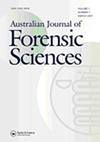DNA mixture analyses of autosomal single nucleotide polymorphisms for individual identification using droplet digital polymerase-chain reaction and massively parallel sequencing in combination with EuroFormix
IF 1.1
4区 医学
Q4 MEDICINE, LEGAL
引用次数: 0
Abstract
ABSTRACTDroplet digital polymerase-chain reaction (ddPCR) and massively parallel sequencing (MPS) can be used to detect an extremely low proportion of non-overlapping single nucleotide polymorphisms (SNPs) of a minor contributor in a DNA mixture. Both semi-continuous and continuous probabilistic likelihood ratio (LR) models can be used to interpret the DNA profiles of mixtures. We analysed 28 identity-informative SNPs in 20 DNA mixtures with various minor to major ratios (1:29, to 1:99) by using our customized ddPCR panel and two MPS panels. The minor contributors of the DNA mixtures were correctly inferred using both semi-continuous and continuous LR models of EuroForMix based on the data of our customized ddPCR and one MPS panel. The accuracy rate of minor contributor assignment was 95% and 90% using semi-continuous and continuous LR models, respectively, using the data of the other MPS panel with lower coverage reads. In conclusion, the quantitative genotype data of SNPs generated using ddPCR can be used for the minor contributor inference for DNA mixtures. The performance of a continuous LR model in minor contributor identification in DNA mixtures may not be superior to that of a semi-continuous LR model when the coverage reads of the MPS panel is insufficient.KEYWORDS: Droplet digital PCRmassively parallel sequencingcontinuous likelihood ratiosemi-continuous likelihood ratiosingle nucleotide polymorphism AcknowledgmentsThe authors acknowledge the technical support of Professor Tsang-Ming Ko and Genefile Bioscience Laboratory for ddPCR experiments. We thank Ai-Jiun Jung for data analysis and manuscript typewriting.Disclosure statementNo potential conflict of interest was reported by the authors.Supplemental dataSupplemental data for this article can be accessed online at https://doi.org/10.1080/00450618.2023.2261511Additional informationFundingThis work was supported by the National Taiwan University Hospital Taiwan, R.O.C. [Grant Number NTUH 106-003500].使用液滴数字聚合酶链反应和大规模平行测序结合EuroFormix进行常染色体单核苷酸多态性的DNA混合物分析,用于个体鉴定
摘要微滴数字聚合酶链反应(ddPCR)和大规模平行测序(MPS)可用于检测DNA混合物中一个次要成分的极低比例的非重叠单核苷酸多态性(snp)。半连续和连续概率似然比(LR)模型均可用于解释混合物的DNA谱。通过使用我们定制的ddPCR面板和两个MPS面板,我们分析了20个DNA混合物中28个具有身份信息的snp,这些DNA混合物具有不同的主要和次要比例(1:29,至1:99)。根据我们定制的ddPCR和一个MPS面板的数据,使用EuroForMix的半连续和连续LR模型正确推断DNA混合物的次要贡献者。使用半连续和连续LR模型,使用其他覆盖率较低的MPS面板的数据,次要贡献者分配的准确率分别为95%和90%。总之,使用ddPCR产生的snp的定量基因型数据可以用于DNA混合物的次要贡献推断。当MPS面板的覆盖读数不足时,连续LR模型在DNA混合物中次要贡献者识别中的性能可能不会优于半连续LR模型。关键词:微滴数字pcr大规模平行测序连续似然比半连续似然比单核苷酸多态性作者感谢高曾明教授和Genefile生物科学实验室对ddPCR实验的技术支持。我们感谢Ai-Jiun Jung的数据分析和稿件打字。披露声明作者未报告潜在的利益冲突。补充数据本文的补充数据可在线访问https://doi.org/10.1080/00450618.2023.2261511Additional . info .本研究得到台湾国立台湾大学医院的支持[批准号:NTUH 106-003500]。
本文章由计算机程序翻译,如有差异,请以英文原文为准。
求助全文
约1分钟内获得全文
求助全文
来源期刊

Australian Journal of Forensic Sciences
MEDICINE, LEGAL-
CiteScore
3.20
自引率
10.00%
发文量
41
审稿时长
>12 weeks
期刊介绍:
The Australian Journal of Forensic Sciences is the official publication of the Australian Academy of Forensic Sciences and helps the Academy meet its Objects.
The Academy invites submission of review articles, research papers, commentaries, book reviews and correspondence relevant to Objects of the Academy. The Editorial policy is to attempt to represent the law, medicine and science and to promote active discussions of the relevant issues of the time as they affect the professional practice of the forensic sciences. The Journal is not restricted to contributions only from Australian authors but it will attempt to represent issues of particular relevance to Australia and its region.
The meetings of the Academy normally include a plenary presentation and the Journal will seek to publish these presentations where appropriate.
 求助内容:
求助内容: 应助结果提醒方式:
应助结果提醒方式:


